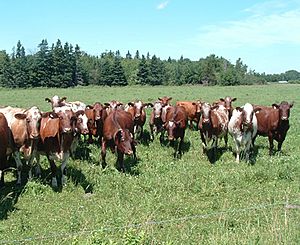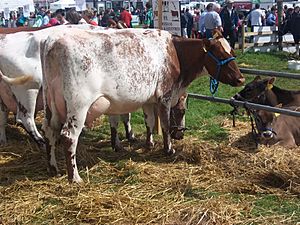Dairy Shorthorn facts for kids
The Dairy Shorthorn is a special type of dairy cow from Britain. It grew from the Shorthorn breed, which first appeared in north-eastern England, in areas like County Durham, Northumberland, and Yorkshire.
This breed is called the Dairy Shorthorn in places like the United Kingdom, Ireland, Australia, and South Africa. But in Canada, New Zealand, and the United States, it's known as the Milking Shorthorn. Another Australian cow breed, the Illawarra cattle, mostly comes from the Dairy Shorthorn. Even the Swedish Red and Norwegian Red breeds have some Shorthorn family in them!
Contents
What Makes Dairy Shorthorns Special?
Dairy Shorthorns are medium-sized cows. Grown-up cows are usually about 140 cm (55 inches) tall at their tail and weigh between 640 to 680 kg (1,410 to 1,500 lb).
Colors and Patterns
You can find them in a few colors:
- Red
- Red with white spots
- White
- Roan (a mix of red and white hairs, which gives them a unique speckled look)
Milk Production and Other Traits
On average, a Dairy Shorthorn cow can produce about 7,000 kg (15,400 lb) of milk in a year. This milk is good quality, with about 3.8% butterfat and 3.3% protein.
These cows are also known for being:
- Very fertile (they have calves easily).
- Good at grazing (eating grass efficiently).
- Easy to manage on a farm.
- Strong and long-lasting.
- Easy to calve (give birth).
Because of these traits, Dairy Shorthorns are a great choice for farms that want to keep things simple and natural.
A Look Back: History of the Breed
The Dairy Shorthorn breed started in the 1700s in north-eastern England. It began in the Tees River Valley, which is near the borders of Durham, Northumberland, and York counties. Farmers named Bates and Booth helped create the "dairy-type" Shorthorn cows on their farms. This special type has continued to thrive ever since.
Spreading Around the World
Dairy Shorthorn cows, sometimes called Durhams long ago, were among the first cows brought to Australia.
The first Shorthorns arrived in the United States in 1783, landing in Maryland and Virginia. More cows were imported in the 1800s, and the breed soon spread across the entire country.
At the World's Exposition in Chicago in 1893, two famous Milking Shorthorn cows, Kitty Clay 3rd and Kitty Clay 4th, showed how good they were at producing milk. Kitty Clay 4th even ranked third for making the most profit among all breeds! These sister cows became the start of the famous Clay cow family.
In New Zealand, Shorthorns were the first dairy cows to arrive in 1814. They were shipped from New South Wales, Australia. These cows were very useful. Farmers used them as strong animals to pull carts, they gave good milk, and they also provided good meat. By the early 1840s, Shorthorn herds were common, and for a long time, they were the most popular cow breed in New Zealand.
Helping Other Breeds Grow
The Dairy Shorthorn breed has also helped create other red dairy cow breeds. These include the Swedish Red cattle, Angeln cattle, and the Illawarra cattle in Australia. Even the Ayrshire cattle breed from Scotland was originally formed from dairy-type Shorthorn cows.
Improving the Breed: Genetic Expansion
To keep the Milking Shorthorn breed strong and healthy, farmers have used a method called "genetic expansion." This means they carefully introduce genes from other red dairy cow breeds. This helps to improve the cows without causing problems that can happen when a small group of animals breeds only among themselves.
Thanks to this, the breed has gotten much better in the last 30 years. They produce more milk and have better body shapes, all while staying true to their unique identity. Farmers often use genes from Red Holstein, Swedish Red, and Illawarra cows to help improve the Milking Shorthorn.
Original Strains
While many Milking Shorthorns have mixed genes, some small groups of these cows have not. They remain very similar to the Shorthorns from the early 1900s. You can find examples of these "original" types in Australia and among the Native Milking Shorthorns in the United States. Sometimes, these cows are called "Dual Purpose Shorthorns" because they are good for both milk and meat.
Dairy Shorthorns Today
After many years of their numbers going down, the Milking/Dairy Shorthorn breed has started to grow in popularity again in several countries. For example, in 2012, the Canadian Milking Shorthorn Society had its highest number of registered cows and members in over 25 years! Farmers, artificial insemination companies, and those who crossbreed cows are showing more interest in Milking Shorthorns.
Who Looks After the Breed?
The Milking/Dairy Shorthorn breed was first recorded in the Coates Herd Book. This was one of the very first official records for cattle in the world! It listed both beef and dairy animals, but kept them in separate sections.
Today, different groups called "breed societies" look after the Milking Shorthorn in various countries. The American Milking Shorthorn Society is the largest, registering over 3,000 animals each year. The Shorthorn Society of Great Britain and Ireland is also very active. You can find registered populations of Milking/Dairy Shorthorns in New Zealand, Canada, Ireland, Australia, and South Africa. The Illawarra Cattle Society of Australia actually has the largest number of cows that are similar to the Milking Shorthorn type.



